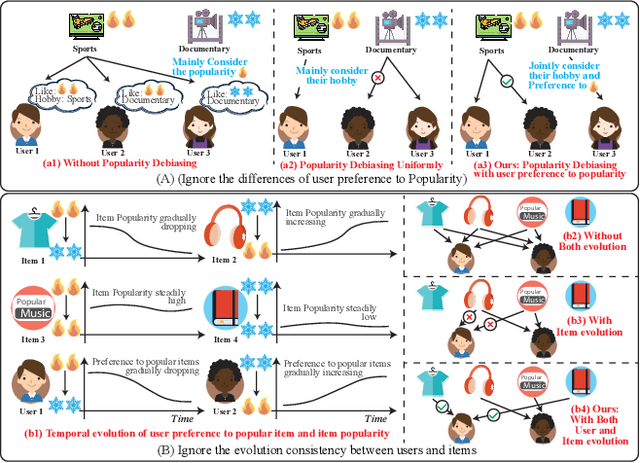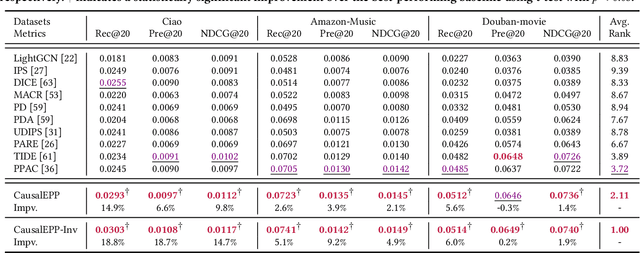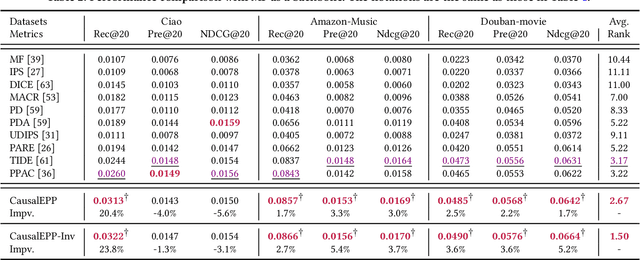Shiyin Tan
Taming Recommendation Bias with Causal Intervention on Evolving Personal Popularity
May 20, 2025



Abstract:Popularity bias occurs when popular items are recommended far more frequently than they should be, negatively impacting both user experience and recommendation accuracy. Existing debiasing methods mitigate popularity bias often uniformly across all users and only partially consider the time evolution of users or items. However, users have different levels of preference for item popularity, and this preference is evolving over time. To address these issues, we propose a novel method called CausalEPP (Causal Intervention on Evolving Personal Popularity) for taming recommendation bias, which accounts for the evolving personal popularity of users. Specifically, we first introduce a metric called {Evolving Personal Popularity} to quantify each user's preference for popular items. Then, we design a causal graph that integrates evolving personal popularity into the conformity effect, and apply deconfounded training to mitigate the popularity bias of the causal graph. During inference, we consider the evolution consistency between users and items to achieve a better recommendation. Empirical studies demonstrate that CausalEPP outperforms baseline methods in reducing popularity bias while improving recommendation accuracy.
A Unified Retrieval Framework with Document Ranking and EDU Filtering for Multi-document Summarization
Apr 23, 2025Abstract:In the field of multi-document summarization (MDS), transformer-based models have demonstrated remarkable success, yet they suffer an input length limitation. Current methods apply truncation after the retrieval process to fit the context length; however, they heavily depend on manually well-crafted queries, which are impractical to create for each document set for MDS. Additionally, these methods retrieve information at a coarse granularity, leading to the inclusion of irrelevant content. To address these issues, we propose a novel retrieval-based framework that integrates query selection and document ranking and shortening into a unified process. Our approach identifies the most salient elementary discourse units (EDUs) from input documents and utilizes them as latent queries. These queries guide the document ranking by calculating relevance scores. Instead of traditional truncation, our approach filters out irrelevant EDUs to fit the context length, ensuring that only critical information is preserved for summarization. We evaluate our framework on multiple MDS datasets, demonstrating consistent improvements in ROUGE metrics while confirming its scalability and flexibility across diverse model architectures. Additionally, we validate its effectiveness through an in-depth analysis, emphasizing its ability to dynamically select appropriate queries and accurately rank documents based on their relevance scores. These results demonstrate that our framework effectively addresses context-length constraints, establishing it as a robust and reliable solution for MDS.
DyG-Mamba: Continuous State Space Modeling on Dynamic Graphs
Aug 13, 2024



Abstract:Dynamic graph learning aims to uncover evolutionary laws in real-world systems, enabling accurate social recommendation (link prediction) or early detection of cancer cells (classification). Inspired by the success of state space models, e.g., Mamba, for efficiently capturing long-term dependencies in language modeling, we propose DyG-Mamba, a new continuous state space model (SSM) for dynamic graph learning. Specifically, we first found that using inputs as control signals for SSM is not suitable for continuous-time dynamic network data with irregular sampling intervals, resulting in models being insensitive to time information and lacking generalization properties. Drawing inspiration from the Ebbinghaus forgetting curve, which suggests that memory of past events is strongly correlated with time intervals rather than specific details of the events themselves, we directly utilize irregular time spans as control signals for SSM to achieve significant robustness and generalization. Through exhaustive experiments on 12 datasets for dynamic link prediction and dynamic node classification tasks, we found that DyG-Mamba achieves state-of-the-art performance on most of the datasets, while also demonstrating significantly improved computation and memory efficiency.
Community-Invariant Graph Contrastive Learning
May 02, 2024



Abstract:Graph augmentation has received great attention in recent years for graph contrastive learning (GCL) to learn well-generalized node/graph representations. However, mainstream GCL methods often favor randomly disrupting graphs for augmentation, which shows limited generalization and inevitably leads to the corruption of high-level graph information, i.e., the graph community. Moreover, current knowledge-based graph augmentation methods can only focus on either topology or node features, causing the model to lack robustness against various types of noise. To address these limitations, this research investigated the role of the graph community in graph augmentation and figured out its crucial advantage for learnable graph augmentation. Based on our observations, we propose a community-invariant GCL framework to maintain graph community structure during learnable graph augmentation. By maximizing the spectral changes, this framework unifies the constraints of both topology and feature augmentation, enhancing the model's robustness. Empirical evidence on 21 benchmark datasets demonstrates the exclusive merits of our framework. Code is released on Github (https://github.com/ShiyinTan/CI-GCL.git).
 Add to Chrome
Add to Chrome Add to Firefox
Add to Firefox Add to Edge
Add to Edge